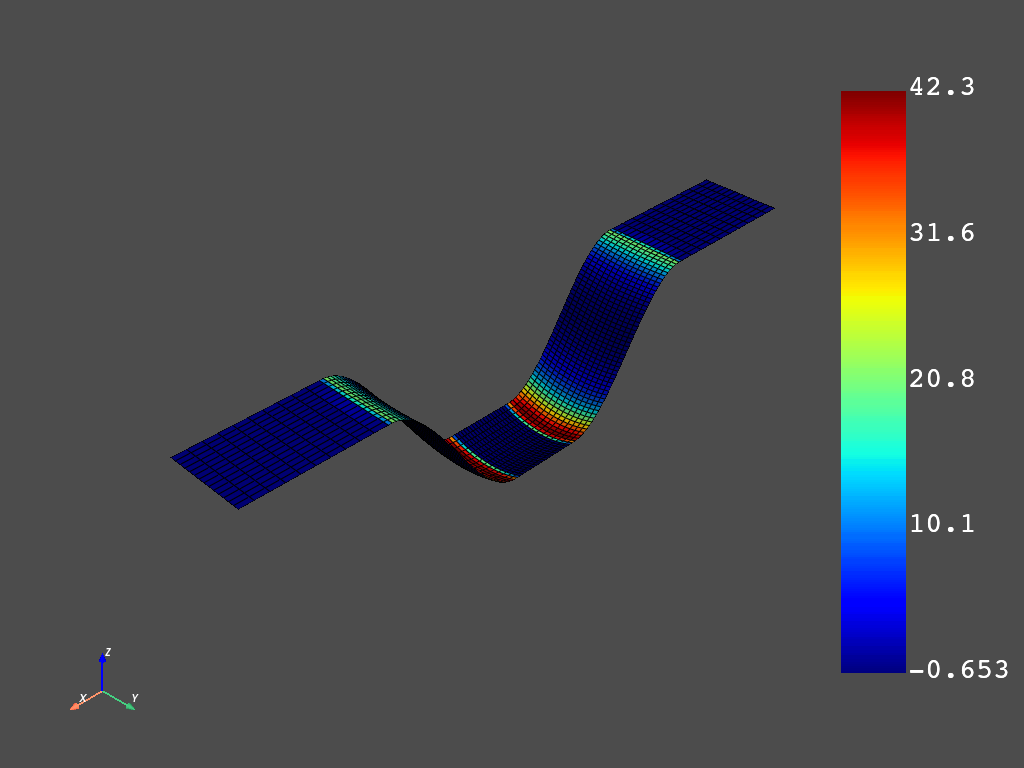Note
Click here to download the full example code
Interlaminar normal stresses#
This example shows how to enrich the stresses of layered shells by computing interlaminar normal stresses. Interlaminar normal stresses can be important in thick and curved laminates.
Because interlaminar normal stresses are typically not available
for layered shell elements, the INS operator is used to recompute
the s3 result based on the laminate strains, the geometrical
curvature, and the lay-up.
Note
For simple use cases, using the composite failure operator or composite sampling point operator is preferable. For examples, see Composite failure analysis and Sampling point. In these workflows, interlaminar normal stresses are computed automatically if required, such as if a 3D failure criterion is activated. Additionally, Filter result data by different criteria shows how helper functions can be used to obtain composite result data.
Set up analysis#
Setting up the analysis consists of loading Ansys libraries, connecting to the DPF server, and retrieving the example files.
Load Ansys libraries.
import ansys.dpf.core as dpf
from ansys.dpf.core import unit_systems
from ansys.dpf.composites.composite_model import CompositeModel
from ansys.dpf.composites.constants import Spot, Sym3x3TensorComponent
from ansys.dpf.composites.example_helper import get_continuous_fiber_example_files
from ansys.dpf.composites.layup_info import AnalysisPlyInfoProvider, get_all_analysis_ply_names
from ansys.dpf.composites.select_indices import get_selected_indices
from ansys.dpf.composites.server_helpers import connect_to_or_start_server
Start a DPF server and copy the example files into the current working directory.
server = connect_to_or_start_server()
composite_files_on_server = get_continuous_fiber_example_files(server, "ins")
Set up model and prepare inputs#
Set up the composite model.
composite_model = CompositeModel(
composite_files_on_server, server, default_unit_system=unit_systems.solver_mks
)
Prepare the inputs for the INS operator.
rotate_to_global is False because the postprocessing engine expects
the results to be in the element coordinate system (material coordinate system).
strain_operator = composite_model.core_model.results.elastic_strain()
strain_operator.inputs.bool_rotate_to_global(False)
stress_operator = composite_model.core_model.results.stress()
stress_operator.inputs.bool_rotate_to_global(False)
Compute interlaminar normal stresses#
Compute the interlaminar normal stresses.
The INS operator stores the stresses in the provided stress field.
composite_model.add_interlaminar_normal_stresses(
stresses=stress_operator.outputs.fields_container(),
strains=strain_operator.outputs.fields_container(),
)
Plot s3 stresses#
Get the first stress field.
stress_field = stress_operator.outputs.fields_container()[0]
Plot the maximum s3 of each element.
s3_component = Sym3x3TensorComponent.TENSOR33
max_s3_field = dpf.field.Field(location=dpf.locations.elemental, nature=dpf.natures.scalar)
with max_s3_field.as_local_field() as local_max_s3_field:
element_ids = stress_field.scoping.ids
for element_id in element_ids:
stress_data = stress_field.get_entity_data_by_id(element_id)
element_info = composite_model.get_element_info(element_id)
assert element_info is not None
# select all stresses from bottom to top of node 0
selected_indices = get_selected_indices(element_info, nodes=[0])
# order is bottom, top, mid
s3 = stress_data[selected_indices, s3_component]
local_max_s3_field.append([max(s3)], element_id)
composite_model.get_mesh().plot(max_s3_field)

Plot s3 at the mid-plane of a certain ply.
analysis_ply_names = get_all_analysis_ply_names(composite_model.get_mesh())
selected_ply = "P3L1__Ply.1"
ply_info_provider = AnalysisPlyInfoProvider(composite_model.get_mesh(), selected_ply)
p8l1_ply_s3_field = dpf.field.Field(location=dpf.locations.elemental, nature=dpf.natures.scalar)
with p8l1_ply_s3_field.as_local_field() as p8l1_ply_s3_field:
element_ids = ply_info_provider.ply_element_ids()
for element_id in element_ids:
stress_data = stress_field.get_entity_data_by_id(element_id)
element_info = composite_model.get_element_info(element_id)
assert element_info is not None
# select all stresses from bottom to top of node 0
layer_index = ply_info_provider.get_layer_index_by_element_id(element_id)
selected_indices = get_selected_indices(
element_info, layers=[layer_index], nodes=[0], spots=[Spot.MIDDLE]
)
# order is bottom, top, mid
s3 = stress_data[selected_indices, s3_component]
p8l1_ply_s3_field.append(s3, element_id)
composite_model.get_mesh().plot(p8l1_ply_s3_field)

Total running time of the script: ( 0 minutes 8.458 seconds)